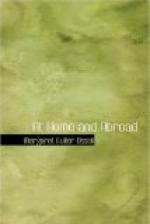Thus speak I generally. To the pictures of Horace Vernet one cannot but turn a gracious eye, they are so faithful a transcript of the life which circulates around us in the present state of things, and we are willing to see his nobles and generals mounted on such excellent horses. De la Roche gives me pleasure; there is in his pictures a simple and natural poesy; he is a man who has in his own heart a well of good water, whence he draws for himself when the streams are mixed with strange soil and bear offensive marks of the bloody battles of life.
The pictures of Leopold Robert I find charming. They are full of vigor and nobleness; they express a nature where all is rich, young, and on a large scale. Those that I have seen are so happily expressive of the thoughts and perceptions of early manhood, I can hardly regret he did not live to enter on another stage of life, the impression now received is so single.
The effort of the French school in Art, as also its main tendency in literature, seems to be to turn the mind inside out, in the coarsest acceptation of such a phrase. Art can only be truly Art by presenting an adequate outward symbol of some fact in the interior life. But then it is a symbol that Art seeks to present, and not the fact itself. These French painters seem to have no idea of this; they have not studied the method of Nature. With the true artist, as with Nature herself, the more full the representation, the more profound and enchanting is the sense of mystery. We look and look, as on a flower of which we cannot scrutinize the secret life, yet b; looking seem constantly drawn nearer to the soul that causes and governs that life. But in the French pictures suffering is represented by streams of blood,—wickedness by the most ghastly contortions.
I saw a movement in the opposite direction in England; it was in Turner’s pictures of the later period. It is well known that Turner, so long an idol of the English public, paints now in a manner which has caused the liveliest dissensions in the world of connoisseurs. There are two parties, one of which maintains, not only that the pictures of the late period are not good, but that they are not pictures at all,—that it is impossible to make out the design, or find what Turner is aiming at by those strange blotches of color. The other party declare that these pictures are not only good, but divine,—that whoever looks upon them in the true manner will not fail to find there somewhat ineffably and transcendently admirable,—the soul of Art. Books have been written to defend this side of the question.




